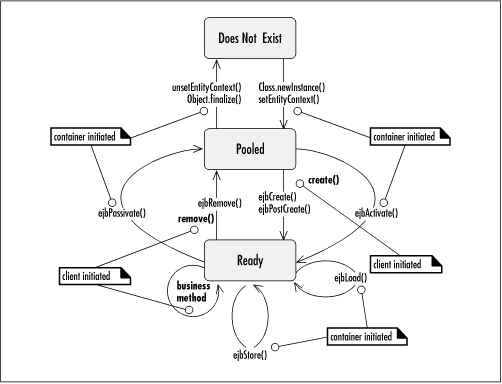The Life Cycle of an Entity Bean
To understand how to best develop entity beans, it is important to understand how the container manages them. The EJB specification defines just about every major event in an entity bean’s life, from the time it is instantiated to the time it is garbage collected. This is called the life cycle, and it provides the bean developer and EJB vendors with all the information they need to develop beans and EJB servers that adhere to a consistent protocol. To understand the life cycle, we will follow an entity instance through several life-cycle events and describe how the container interacts with the entity bean during these events. Figure 6.2 illustrates the life cycle of an entity instance.

Figure 6-2. Entity bean life cycle
We will examine the life cycle of an entity bean and identify the
points at which the container would call each of the methods
described in the
EntityBean
interface. Bean instances must
implement the EntityBean interface, which means
that invocations of the
callback methods are
invocations on the bean instance itself.
Does Not Exist
The bean instance begins life as a collection of files. Included in that collection are the bean’s deployment descriptor, the remote interface, the home interface, the primary key, and all the supporting classes generated at deployment time. At this stage, no instance of the bean exists.
The Pooled State ...
Get Enterprise JavaBeans, Second Edition now with the O’Reilly learning platform.
O’Reilly members experience books, live events, courses curated by job role, and more from O’Reilly and nearly 200 top publishers.

